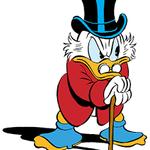Voyager 1 und 2
10.06.2024 um 17:02Voyager soll trotzdem leistungsfähiger wie der Galileo Bordrechner gewesen sein weil man dort eine normale 8Bit CPU genommen hat und es in den 70ern nicht viel gab
Kommt drauf an was man darunter versteht. Die damaligen Computer waren elend langsam getaktet und hatten einen sehr kleinen Speicherplatz. Ende der 70er für Heimanwender im Kilobytebereich.TePe schrieb:Voyager soll trotzdem leistungsfähiger wie der Galileo Bordrechner gewesen sein
Ja, in den FAQs: https://voyager.jpl.nasa.gov/frequently-asked-questions/ (Archiv-Version vom 06.06.2024)Lupo54 schrieb:Gibt es darüber irgendwo Daten?
There are three different computer types on the Voyager spacecraft and there are two of each kind. Total number of words among the six computers is about 32K.und
Computer Command System (CCS) - 18-bit word, interrupt type processors (2) with 4096 words each of plated wire, non-volatile memory.
Flight Data System (FDS) - 16-bit word machine (2) with modular memories and 8198 words each
Attitude and Articulation Control System (AACS) - 18-bit word machines (2) with 4096 words each.
According to my calculations, that's a total of about 68KB, or small potatoes compared to today's microprocessors. We probably could perform all functions with one of today's boards and still have room for solid state data storage and much more fault detection software. We would still need a second unit for redundancy. Today's microprocessors are also much faster than the chips used on Voyager and a comparative system would use less electrical power. On the other hand, software might be more complicated as opposed to that used in an interrupt type system, but it would be much more capable and more flexible.
Let's look closer at the CCS. The CCS has two main functions: to carry out instructions from the ground to operate the spacecraft, and to be alert for a problem or malfunction and respond to it. Two identical 4096- word memories contain both fixed routines (about 2800 words) and a variable section (about 1290 words) for changing science sequences. The CCS issues commands to the AACS for movement of the scan platform or spacecraft maneuvers; to the FDS for changes in instrument configurations or telemetry rates and to numerous other subsystems within the spacecraft for specific actions. Fault-protection algorithms are also stored in the CCS, occupying roughly 10 percent of the CCS memory.
The main functions of the FDS are to collect data from, and controls the operations of, the scientific instruments; and to format engineering and science data for on-board storage and/or real-time transmission. The FDS also keeps the spacecraft "time" and provides frequency references to the instruments and other spacecraft subsystems.
The Voyager spacecraft computers are interrupt driven computer, similar to processors used in general purpose computers with a few special instructions for increased efficiency. The programming is a form of assembly language.
There is no clock chip, as such, in the spacecraft. The "clock" is really a counter, based on one of several electronically generated frequencies. These frequencies, based on a reference, generated by a very stable oscillator, are converted and fed to different locations in the spacecraft as synchronization signals, timers, counters, etc. The "clock" signal is part of the information telemetered to the ground and it is with ground software that we convert to day of year, time of day Greenwich Mean Time.
Not very fast compared to today’s standards. The master clock runs at 4 MHz but the CPU’s clock runs at only 250 KHz. A typical instruction takes 80 microseconds, that is about 8,000 instructions per second. To put this in perspective, a 2013 top-of-the-line smartphone runs at 1.5 GHz with four or more processors yielding over 14 billion instructions per second.
? welche Sonde ? Beide Voyager sind doch schon 1977 gestartet...die Shuttles verunglückten 1986 und 2003.TePe schrieb:Die Sonde sollte auch schon 1982 starten das verzögerte sich durch das Unglück des Shuttles fast um 10 Jahre
So ist es. Zur Mondlandung waren noch einfachere Systeme im Einsatz .TePe schrieb:Die NASA hatte zur Mondlandung immerhin schon IBM Maschinen mit 1,5 MByte in 32Bit Technik.
Ich meinte die Galileo Jupiter Sonde die sollte ursprünglich Anfang der 80er starten rutschte dann aber immer mehr nach hinten und dann durfte nach dem Challenger Unglück die Wasserstoff Kickstufe nicht benutzt werden sondern nur eine mit Feststoff was einen Umweg über Venus erforderte.Abahatschi schrieb:sich durch das Unglück des Shuttles fast um 10 Jahre
? welche Sonde ? Beide Voyager sind doch schon 1977 gestartet...die Shuttles verunglückten 1986 und 2003.
Ich verstehe deinen Post nicht.
NajaTePe schrieb am 10.06.2024:Voyager soll trotzdem leistungsfähiger wie der Galileo Bordrechner gewesen sein weil man dort eine normale 8Bit CPU genommen hat und es in den 70ern nicht viel gab

Schon der Wahnsinn, wie schnell sich das entwickelt hat. Ich bin auch mit dem C64 und 64 Kb RAM eingestiegen. Damals reichte das für ne Sonde und heute nicht mal mehr für eine ArmbanduhrJosephConrad schrieb:1977 gar es auch schon den APPLE-II (6502) mit bis zu 48kb RAM, 1982 den Apollo DN100 mit 68000.
Du kannst heute, wie damals eine digitale Armbanduhr mit einfachen Schieberegistern aufbauen. Der Anspruch hat sich geändert, wenn du eine SmartWatch meinst ;)alhambra schrieb:Damals reichte das für ne Sonde und heute nicht mal mehr für eine Armbanduhr
Um diese Zeit gab es praktisch von Monat zu Monat eine Weiterentwicklung. Die Elektronik in den Sonden dürfte beim Start schon veraltet gewesen sein. Aber sie ist solide, alle Bauteile gut ausgewählt und eine gute Redundanz für Ausfälle. Sonst hätte sie nicht so lange durchgehalten.alhambra schrieb:Schon der Wahnsinn, wie schnell sich das entwickelt hat.
Nur das Voyager eher Stand Ende 1960 Anfang 1970 ist.JosephConrad schrieb am 17.06.2024:Naja
der 6502 mit 8 Bit kam 1975, der 68000 mit 32 Bit kam 1979 heraus.

Die Nasa hat ein Experiment zu kosmischer Strahlung an Bord der Sonde „Voyager 1“ abgeschaltet und wird Ende März das „Low-Energy Charged Particle“-Instrument“ von „Voyager 2“ deaktivieren.
Beide Raumsonden haben dann jeweils noch drei von zehn funktionierenden Instrumenten – funktionieren jedoch noch weiter. „Die ‚Voyagers‘ sind seit ihrem Start die Stars im Weltraum und wir wollen, dass das so lange wie möglich so bleibt“, erklärt die „Voyager“-Projektleiterin Suzanne Dodd in einer Mitteilung des Jet Propulsion Laboratory (JPL) der Nasa. „Aber die elektrische Energie wird knapp. Wenn wir jetzt nicht auf jeder ‚Voyager‘ ein Instrument abschalten, haben sie wahrscheinlich nur noch ein paar Monate Energie, bevor wir das Ende der Mission verkünden müssen.“Quelle: https://www.fr.de/wissen/nasa-schaltet-instrumente-der-voyager-raumsonden-ab-elektrische-energie-wird-knapp-zr-93610556.html
Hier nochmal detaillierte Infos:Teegarden schrieb:Wenn wir jetzt nicht auf jeder ‚Voyager‘ ein Instrument abschalten, haben sie wahrscheinlich nur noch ein paar Monate Energie, bevor wir das Ende der Mission verkünden müssen.
Der Gesamtwirkungsgrad (elektrischer Strom/Wärmeabgabe) ist gering und liegt nur bei 8 %, dies ist trotzdem um 30 % besser als noch zu den Voyagersonden, als man aus einem 120 kg schweren RTG 480 Watt Strom gewinnen.......Quelle: https://www.bernd-leitenberger.de/cassini-rtg.shtml
Bei den Voyager, die schon 1977 starteten erreichen die RTG erst im Jahre 2020 eine Leistung von 245 Watt (480 Watt beim Start), dies entspricht einer Abnahme um 1.6 % pro Jahr. Dies ist jedoch ein Mittel. RTGs verhalten sich nicht linear, d.h. die Energie nimmt zuerst stark ab, dann immer langsamer. Es spielt neben der abnehmenden Wärmeabgabe auch Alterungseffekte der Thermoelemente eine Rolle sowie ein sinkender Wirkungsgrad bei geringeren Temperaturunterschieden. Daher eigenen sich RTG für Langzeitmissionen besonders gut.
Als die beiden „Voyager“-Sonden der Nasa die Grenze zwischen Heliosphäre und Heliopause durchquerten, trafen sie auf eine „Wand aus Feuer“ – die Instrumente der Raumsonden maßen Temperaturen von 30.000 bis 50.000 Grad Celsius.
Trotz dieser unvorstellbar hohen Temperaturen kamen die „Voyager“-Raumsonden unbeschadet durch die „Wand aus Feuer“ – weil das heiße Plasma in dieser Region so weit verteilt ist, dass es den Sonden nichts anhaben konnte. Übrigens ist der Name „Wand aus Feuer“ auch nicht ganz treffend – denn obwohl es in der Heliopause unglaublich heiß ist, gibt es dort kein Feuer, also eine sichtbare Verbrennung mit einer Flamme. Schließlich benötigt Feuer Sauerstoff – und den gibt es im Weltall nicht.Quelle: https://www.fr.de/wissen/durch-die-wand-aus-feuer-voyager-raumsonden-der-nasa-ueberlebten-die-hitze-zr-93783652.html
Man spricht bei roten Überriesen auch von einem roten Vakkuum. So gigantisch sie sind, so gering ist die Dichte ihrer äußeren Schichten. Von der Temperatur dort würde man auch nichts mitbekommen. Wahrscheinlich nicht mal, dass man gerade durch einen Stern durchfliegt...Teegarden schrieb:Interessant, war mir bisher nicht so wirklich bewusst.

Die RTG an Bord der beiden Sonden verlieren seit dem Start der Mission kontinuirlich an Leistung. Desshalb wurden nach und nach verschiedene Experimente und Systeme an Bord abgeschaltet. Aktuell geht die Nasa davon aus das man noch bis ca 2035 genug Energie hat um eine Verbindung mit den Sonden aufrecht zu halten. Die RTG werden aber noch Jahrunderte lang weiter Energie abgeben. Nur halt zu wenigduval schrieb:Gibt es Prognosen wann die RTGs bei beiden Sonden ausfallen werden.?
